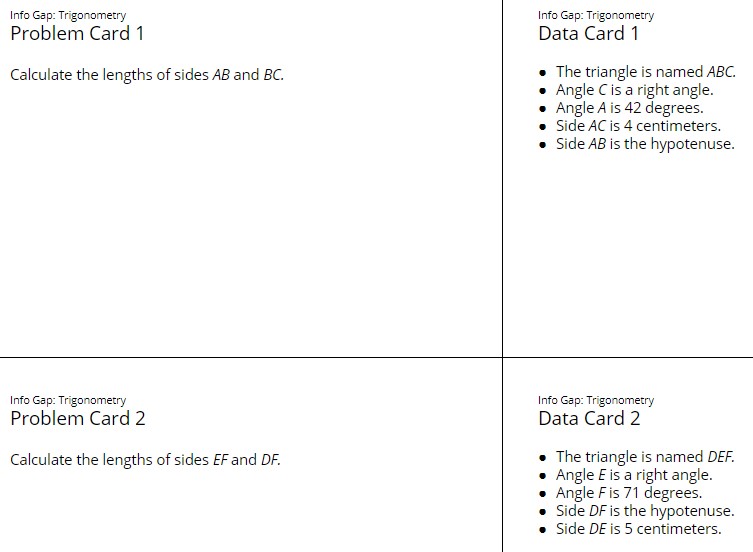Lesson 7
Applying Ratios in Right Triangles
7.1: Tilted Triangle (5 minutes)
Warm-up
Students are asked to calculate side lengths of a right triangle. They can apply their new understanding from the previous lesson and use trigonometry.
Student Facing
Calculate the lengths of sides \(AC\) and \(BC\).

Student Response
For access, consult one of our IM Certified Partners.
Activity Synthesis
Remind students that \(\sin(20)\) is shorthand for “the length of the side opposite the 20 degree angle divided by the length of the hypotenuse for any right triangle with an acute angle of 20 degrees.” So when they ask the calculator to display \(\sin(20)\), they are asking the calculator for the ratio that is constant for all the triangles similar to this one by the Angle-Angle Triangle Similarity Theorem.
7.2: Info Gap: Trigonometry (20 minutes)
Activity
This info gap activity gives students an opportunity to determine and request the information needed to calculate side lengths of right triangles using trigonometry.
The info gap structure requires students to make sense of problems by determining what information is necessary, and then to ask for information they need to solve it. This may take several rounds of discussion if their first requests do not yield the information they need (MP1). It also allows them to refine the language they use and ask increasingly more precise questions until they get the information they need (MP6).
Here is the text of the cards for reference and planning:

Launch
Tell students they will continue to use trigonometry to solve for side lengths of right triangles. Explain the info gap structure, and consider demonstrating the protocol if students are unfamiliar with it.
Arrange students in groups of 2. In each group, distribute a problem card to one student and a data card to the other student. After reviewing their work on the first problem, give them the cards for a second problem and instruct them to switch roles.
Design Principle(s): Cultivate Conversation
Supports accessibility for: Memory; Organization
Student Facing
Your teacher will give you either a problem card or a data card. Do not show or read your card to your partner.
If your teacher gives you the data card:
- Silently read the information on your card.
- Ask your partner, “What specific information do you need?” and wait for your partner to ask for information. Only give information that is on your card. (Do not figure out anything for your partner!)
- Before telling your partner the information, ask “Why do you need to know (that piece of information)?”
- Read the problem card, and solve the problem independently.
- Share the data card, and discuss your reasoning.
If your teacher gives you the problem card:
- Silently read your card and think about what information you need to answer the question.
- Ask your partner for the specific information that you need.
- Explain to your partner how you are using the information to solve the problem.
- When you have enough information, share the problem card with your partner, and solve the problem independently.
- Read the data card, and discuss your reasoning.
Pause here so your teacher can review your work. Ask your teacher for a new set of cards and repeat the activity, trading roles with your partner.
Student Response
For access, consult one of our IM Certified Partners.
Activity Synthesis
After students have completed their work, share the correct answers and ask students to discuss the process of solving the problems. Here are some questions for discussion:
- “What information did you need to ask for?” (What letters and where they go. An acute angle and a side length.)
- “What could you figure out once you knew angle \(C\) was the right angle?” (The legs of the right triangle both have the letter \(C\) and the hypotenuse uses the other two letters)
Highlight for students that drawing a diagram and labeling it with the information provided is an important strategy. It’s too easy to forget something or mix up information without a clear diagram to work from.
7.3: Tallest Tower (10 minutes)
Activity
Students continue to use trigonometry to calculate side lengths of right triangles. In this case they apply that skill to a real world context and engage in some error analysis during the synthesis.
Launch
Consider showing where Dubai and Philadelphia are on a map and defining masonry.
Design Principle(s): Optimize output (for explanation)
Supports accessibility for: Language; Organization
Student Facing
-
The tallest building in the world is the Burj Khalifa in Dubai (as of April 2019).
If you’re standing on the bridge 250 meters from the bottom of the building, you have to look up at a 73 degree angle to see the top. How tall is the building? Explain or show your reasoning.

-
The tallest masonry building in the world is City Hall in Philadelphia (as of April 2019). If you’re standing on the street 1,300 feet from the bottom of the building, you have to look up at a 23 degree angle to see the top. How tall is the building? Explain or show your reasoning.
Student Response
For access, consult one of our IM Certified Partners.
Student Facing
Are you ready for more?
You’re sitting on a ledge 300 feet from a building. You have to look up 60 degrees to see the top of the building and down 15 degrees to see the bottom of the building. How tall is the building?
Student Response
For access, consult one of our IM Certified Partners.
Anticipated Misconceptions
If students struggle with the city hall question prompt then to draw a diagram with the information they know.
Activity Synthesis
Display this image of the Philadelphia City Hall:

“The exact heights are 829.8 meters for the Burj Khalifa and 548 feet for City Hall. Why don’t those numbers match your calculations?” (Rounding or measurement error. The difference between \(\tan(23)\) and \(\tan(23.2)\) makes a big difference when you work with large numbers.) "Is it reasonable to assume you are accurate to the nearest tenth in this case?" (No, the provided measurements were rounded to the nearest ten meters or hundred feet so our usual rounding scheme doesn't apply.)
Lesson Synthesis
Lesson Synthesis
Tell students, “In addition to measuring the heights of objects that are too tall to reach, professionals also use trigonometry to calculate the heights of objects they are designing. For example, here is some information a billboard designer knows about a new site.”
Display this information:
- The local law says the maximum height from the ground to the top of any billboard is 50 feet.
- To see over the trees from the highway people need to look up at least 40 degrees.
- The highway is 47 feet from the billboard.
Invite students to discuss what they can do with this information. (How tall—from bottom to top of the image—can the billboard be?) Then invite students to answer the questions they generated. (To be above the trees the bottom of the billboard must be 39.4 feet off the ground, so the billboard can be up to 10.6 feet tall.)
7.4: Cool-down - Tallest Tree (5 minutes)
Cool-Down
For access, consult one of our IM Certified Partners.
Student Lesson Summary
Student Facing
Using trigonometry and properties of right triangles, we can calculate and estimate measures in different right triangles. We can use these skills to estimate unknown heights of objects that are too tall to measure directly. For example, we can't reach the top of this tree with a measuring tape.

To calculate the height of the tree, we could stand where the angle between the top and bottom of the tree is 10 degrees. Since we know the distance to the tree (the adjacent leg) and would like to know the height (the opposite leg), we need to use tangent. So \(\tan(10)=\frac{h}{100}\). In the calculator we can look up that \(\tan(10)\) is 0.176. Then we can calculate that \(h\) is about 17.6. That means the tree is 17.6 feet tall.